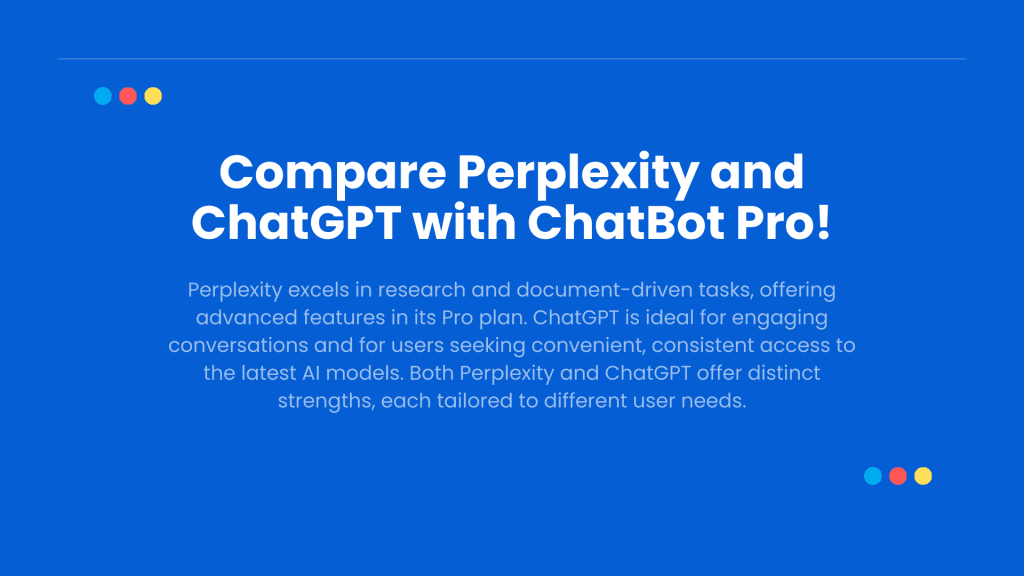In the dynamic world of artificial intelligence, large language models (LLMs) are revolutionizing how we access and interact with information. Two prominent players in this field, Perplexity and ChatGPT, have gained traction for their unique features and capabilities. As users increasingly turn to these models for various applications—from research assistance to creative writing—understanding their differences is essential for making informed choices.
 Perplexity is designed to deliver precise, real-time answers sourced from the web, ensuring users receive the most accurate information available. On the other side of the fence, ChatGPT excels in generating human-like dialogue and creative content, making it a versatile tool for a wide range of conversational tasks. We’ll explore the key distinctions between Perplexity vs ChatGPT, examining their functionalities, accuracy, interaction styles, and pricing. By highlighting the strengths and limitations of each model, we aim to provide you with the insights necessary to select the best tool for your specific needs. Whether you're a researcher, a content creator, or simply an AI enthusiast, understanding these two powerful models will enhance your ability to leverage their capabilities effectively!
Perplexity is designed to deliver precise, real-time answers sourced from the web, ensuring users receive the most accurate information available. On the other side of the fence, ChatGPT excels in generating human-like dialogue and creative content, making it a versatile tool for a wide range of conversational tasks. We’ll explore the key distinctions between Perplexity vs ChatGPT, examining their functionalities, accuracy, interaction styles, and pricing. By highlighting the strengths and limitations of each model, we aim to provide you with the insights necessary to select the best tool for your specific needs. Whether you're a researcher, a content creator, or simply an AI enthusiast, understanding these two powerful models will enhance your ability to leverage their capabilities effectively!
Data and Knowledge Base: Perplexity vs ChatGPT
The foundation of any LLM lies in its data and knowledge base, which significantly influences its ability to provide accurate and relevant information. In this section, we will explore how these models differ in their approaches to sourcing information.
Perplexity's Focus on Using Up-to-Date Web Sources and Citation Transparency
Perplexity excels in providing real-time, accurate information by leveraging its capability to conduct live web searches. This approach allows it to access a diverse array of current sources, including academic databases, news articles, and other reputable online content. By continually pulling from the latest available data, the model ensures that users receive timely and relevant answers to their queries. This focus not only enhances the quality of information but also positions it as a valuable tool for research and knowledge discovery.
Another notable feature is its commitment to transparency through source citation. Each answer it generates is accompanied by references to the specific web pages or academic papers consulted during the information retrieval process. Having this fosters trust and allows users to verify the information presented, encouraging further exploration of the topic. By providing citations, Perplexity not only enhances its credibility but also empowers users to delve deeper into the subject matter, making it particularly valuable for academic research and professional inquiries.
ChatGPT's Training on a Large Corpus of Internet Data
ChatGPT is trained on a vast corpus of internet data, which includes a wide range of textual information. However, this training comes with limitations, as it does not have the ability to perform real-time searches. Consequently, the information it provides may be outdated or less reliable, particularly for rapidly changing subjects or recent events. Users may encounter instances where ChatGPT's responses reflect knowledge that is no longer current, leading to potential inaccuracies. While ChatGPT's extensive training enables it to generate coherent and contextually relevant responses, the lack of real-time data access can hinder its effectiveness in providing the most up-to-date information. This distinction is crucial for users who prioritize accuracy and timeliness in their inquiries.
Interaction Styles: Perplexity vs ChatGPT
The way users interact with AI models significantly impacts their experience and satisfaction. This section explores the distinct interaction styles of these LLMs, highlighting how they cater to different user needs and preferences.

Perplexity’s Structured Approach
Perplexity is designed with a structured approach that is particularly beneficial for users seeking detailed and accurate information. Its interface allows for straightforward querying, resembling traditional search engines, yet it goes beyond simple keyword matching by understanding user intent.
This capability enables it to discern the context of complex questions, providing tailored and relevant responses. The model excels in delivering in-depth answers, often integrating various sources to enrich the information provided. For instance, when users pose research-oriented queries, the model offers comprehensive summaries, citations, and even multimedia content, such as images and videos, to enhance understanding. This structured interaction style is especially advantageous for academics, researchers, and professionals who require reliable and well-sourced information for their work.
Additionally, Perplexity's Copilot feature refines search results through interactive queries, allowing users to ask follow-up questions and explore topics in greater depth. This functionality not only facilitates a more engaging experience but also helps users navigate complex subjects with ease.
ChatGPT's Natural Conversational Style
ChatGPT is characterized by its natural conversational style, making it an ideal choice for users seeking engaging and dynamic interactions. The model is adept at generating human-like responses and can maintain context over extended conversations, allowing for a more fluid exchange of ideas. This conversational ability makes it particularly appealing for casual users, creative writers, and those looking for brainstorming assistance.
The model also thrives in open-ended dialogue, where users can explore topics freely and receive responses that feel intuitive and relatable. It can handle a wide range of prompts, from casual inquiries to complex discussions, adapting its tone and style to match the user's input. This flexibility fosters a more personalized experience, as users can engage with the model in a manner that feels natural and engaging.
However, while its conversational style is a strength, it may lead to instances of inaccuracies or less precise information, particularly when users seek highly specific or technical answers. Users should be mindful of this when utilizing ChatGPT for research or factual inquiries.
User Preferences and Requirements

Ultimately, the choice will depend on individual user preferences and requirements. Those who prioritize structured, accurate, and sourced information may find Perplexity to be the more suitable option, especially for research and academic purposes. Its emphasis on context and citation transparency enhances its reliability, making it a trusted resource for users seeking factual answers. Conversely, users looking for a more conversational and engaging experience may prefer ChatGPT. Its ability to generate human-like dialogue and adapt to various conversational styles makes it an excellent choice for creative tasks, casual inquiries, and brainstorming sessions.
Functionality: Perplexity vs ChatGPT
The versatility and functionality of LLMs play a crucial role in their usability across various applications. In this section, we will examine the diverse capabilities of ChatGPT and Perplexity, highlighting their unique strengths and customization options that cater to different user needs.

ChatGPT's Wide Range of Applications
ChatGPT is renowned for its extensive range of applications, making it a powerful tool for various tasks. Its capabilities include:- Content Creation: ChatGPT can generate high-quality written content for blogs, articles, marketing materials, and social media posts. This ability makes it a valuable asset for content creators and marketers looking to streamline their workflow.
- Coding Assistance: The model can write code snippets, debug existing code, and provide suggestions for code optimization. This functionality is particularly beneficial for developers who need quick solutions or assistance with programming tasks, such as file manipulation or database queries.
- Task Completion: ChatGPT can assist with a variety of office tasks, including drafting emails, creating presentations, and organizing information. Its ability to understand context allows it to generate relevant content tailored to specific needs, enhancing productivity across different professional settings.
- Educational Support: ChatGPT can help students with homework, provide explanations for complex concepts, and assist teachers in developing lesson plans and educational materials. This versatility makes it a valuable resource in both academic and professional environments.
- Multimodal Capabilities: With the introduction of the GPT-4o model, ChatGPT has become multimodal, allowing it to respond to audio and image prompts. This feature enhances its utility in real-world situations, such as translating menus or identifying objects in photos.
Perplexity's Focus on Search-Like Queries
Perplexity is primarily designed for search-like queries and information lookup. Its functionality is centered around providing accurate, sourced answers to user inquiries, making it an ideal tool for research and knowledge discovery. Key features include:- Real-Time Information Retrieval: Perplexity's ability to conduct live web searches enables it to deliver up-to-date information, making it particularly useful for users seeking current data or insights on specific topics.
- Structured Responses: The model excels in synthesizing information from multiple sources to generate comprehensive answers. This structured approach allows users to gain a deeper understanding of complex subjects.
- Citation Transparency: The model’s commitment to citing sources enhances its reliability, allowing users to verify the information and explore further if desired. This feature is especially valuable for academic research and professional inquiries.
Customization Options in Both Models
Both ChatGPT and Perplexity offer customization options that enhance user experience:- ChatGPT's Custom Instructions: Users can provide specific instructions to ChatGPT, tailoring its responses to better suit their preferences. This feature allows for a more personalized interaction, making it easier to achieve desired outcomes in various tasks.
- Perplexity's Writing Modes: The AI offers different writing modes that cater to various needs, such as academic writing or casual inquiries. This flexibility allows users to choose the most appropriate mode based on the context of their questions.
In summary, the versatility and functionality of ChatGPT and Perplexity cater to different user needs. ChatGPT's broad range of applications, from content creation to coding assistance, makes it a versatile tool for many tasks, while Perplexity's focus on real-time information retrieval and citation transparency positions it as a reliable resource for research and knowledge discovery. By understanding these differences, users can select the model that best aligns with their professional and personal needs.
Accessibility: Perplexity vs ChatGPT
Understanding the pricing and accessibility is crucial for users looking to leverage their capabilities effectively. This section will explore the pricing structures of Perplexity and ChatGPT, highlighting their free and paid plans, as well as the features associated with each option.
Perplexity's Free Plan and Paid Pro Plan

Perplexity offers a free plan that allows users to access its core search functionalities without any cost. However, this plan comes with limitations, such as a restricted number of "pro" searches per month. Users seeking enhanced features can opt for the Perplexity Pro plan, which is priced at $20 per month or $200 annually, offering a savings of $40 for those who commit to a yearly subscription. The Pro plan unlocks several advanced features, including:
- Unlimited Pro Searches: Users can conduct an unlimited number of searches, providing greater flexibility for research and information retrieval.
- Unlimited File Uploads: Pro users can upload documents, images, and PDFs, allowing for more comprehensive inquiries and interactions with the AI.
- Longer Conversations: The Pro plan enables extended dialogues with the AI, facilitating deeper exploration of topics and more detailed responses.
- Priority Access: Subscribers receive priority access to the latest AI models and features, including integration with advanced models like GPT-4 and Claude 3.
- API Access: The Pro plan includes API credits, enabling developers to integrate Perplexity's capabilities into their applications.
Additionally, Perplexity offers a 7-day free trial for users to test the Pro features before committing to a subscription.
ChatGPT's Free and Paid Plus Plans

ChatGPT also provides users with both free and paid options. The free plan allows access to the model's basic functionalities, though it may have limitations in terms of the number of queries and access to the latest features. For users seeking enhanced performance, ChatGPT offers a paid subscription known as ChatGPT Plus, priced at $20 per month. The Plus plan includes several advantages:
- Priority Access: Subscribers receive priority access to the model, reducing wait times during peak usage periods.
- Access to Latest Models: ChatGPT Plus users can utilize the latest versions of the model, which often include improvements in performance and accuracy.
- Increased Availability: The Plus plan ensures users have more consistent access to the service, particularly during high-demand periods.
Comparison of Pricing and Structures and Subscription Options

When comparing the pricing structures of these two models, several key differences emerge. Both platforms offer free access, but Perplexity's free plan is more limited in terms of search capabilities compared to ChatGPT. The Pro plan provides a comprehensive suite of features tailored for in-depth research, while ChatGPT Plus focuses on enhancing user experience through priority access and the latest model updates. Safe to say that both Perplexity and ChatGPT present viable options for users, with distinct pricing structures that cater to varying needs. Perplexity is particularly suited for those requiring extensive research capabilities and document handling, while ChatGPT appeals to users looking for a conversational AI experience with consistent access and the latest advancements.
Compare Perplexity and ChatGPT with ChatBot Pro!
In the competitive landscape of LLMs, Perplexity and ChatGPT each offer distinct strengths tailored to different user needs.

Perplexity excels in providing real-time, sourced information, making it ideal for research and complex inquiries. On the other hand, ChatGPT shines with its conversational style and versatility, catering to a wide range of applications, from content creation to coding assistance. When considering pricing and accessibility, both models offer free and paid plans, allowing users to choose based on their specific requirements and budget.

To truly understand the capabilities of both models, we encourage you to explore AI-Pro’s ChatBot Pro, which allows you to switch between different AI models and compare their outputs directly. Experience the strengths of each LLM and find the one that best meets your needs!





